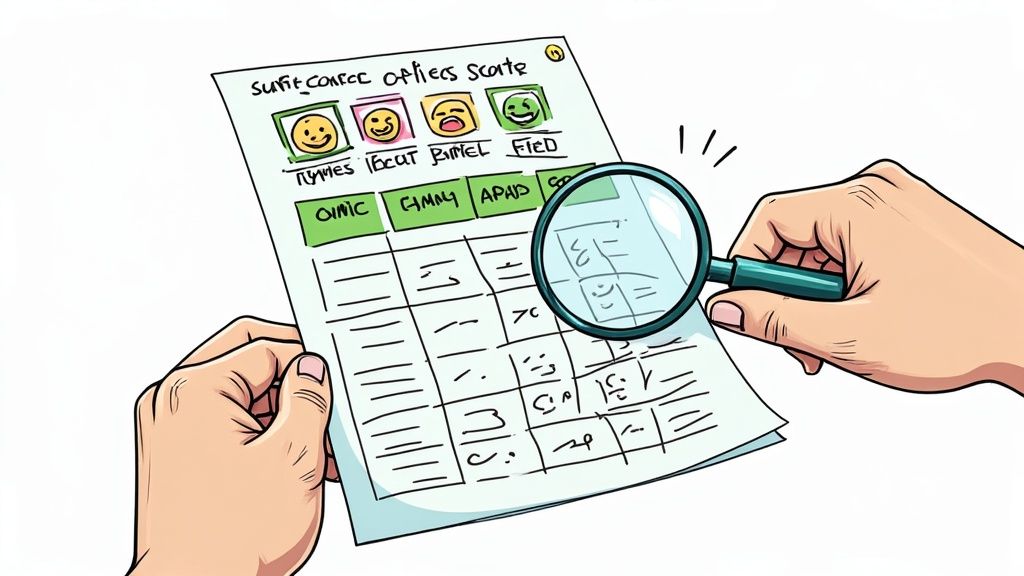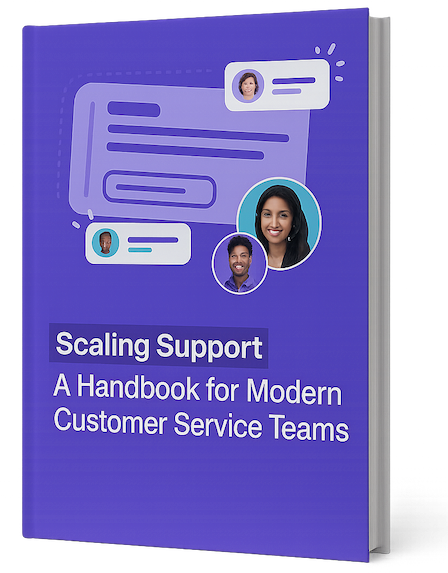Simple satisfaction surveys with basic questions like “How satisfied are you?” often miss the bigger picture of customer sentiment. While a customer might report being satisfied after one interaction, they could still end their relationship with your company days later due to ongoing small frustrations. This highlights why relying on basic metrics alone can be misleading.
The Problem With One-Dimensional Measurement
Looking at just one aspect of the customer experience is like trying to diagnose car troubles by checking only the oil level. Tools like CSAT and NPS provide useful data points, but they’re just pieces of a larger puzzle. A customer might give high scores on standard surveys while quietly growing frustrated with aspects you aren’t measuring. To truly understand your customers’ needs and pain points, you need a more complete view of their experience.
Embracing a Holistic Approach to Measuring Customer Satisfaction
Smart companies now combine multiple data sources to build a complete picture of customer health, including:
- Transactional Surveys: Getting feedback right after purchases or support interactions
- Relationship Surveys: Measuring overall satisfaction over time
- Social Media Monitoring: Watching what customers say about you online
- Behavioral Data: Looking at how customers use your products and services
Numbers only tell part of the story though. The real insights often come from asking “why” – through open-ended survey questions, review comments, and conversations with support teams. These qualitative insights reveal the real reasons behind customer satisfaction or frustration.
Building a Measurement Program That Works
Creating an effective measurement system requires careful planning:
- Define Clear Objectives: Know exactly what you want to learn about your customers
- Identify Key Touchpoints: Focus on the most important moments in your customer relationships
- Choose Relevant Metrics: Pick measurements that align with your goals
- Create Actionable Insights: Connect the data to specific improvements you can make
Moving beyond basic satisfaction scores gives you deeper insights into what your customers really think and feel. This helps you spot problems early, make smart improvements, and build stronger customer relationships. The companies that understand their customers best are the ones that keep them longest.
Mastering Net Promoter Score (NPS) That Actually Drives Growth

Basic satisfaction metrics only tell part of the story. To truly understand customer loyalty and predict future growth, many companies use Net Promoter Score (NPS). The key is not just tracking the score itself, but knowing how to act on the insights it provides.
Understanding the NPS Framework
NPS centers on one key question: “How likely are you to recommend [brand/product/service] to a friend or colleague?” Customers rate their likelihood on a 0-10 scale, falling into three groups:
- Detractors (0-6): These unhappy customers may actively discourage others from using your brand and are at risk of leaving.
- Passives (7-8): While satisfied, these customers lack enthusiasm and could switch to competitors.
- Promoters (9-10): Your brand champions who drive growth through positive word-of-mouth and referrals.
To calculate your NPS, subtract the percentage of detractors from promoters. For example, with 60% promoters and 20% detractors, your NPS would be 40.
Moving Beyond the Number: Actionable Insights From NPS
The real power of NPS comes from understanding the “why” behind the scores. Break down your NPS data by customer segments, product usage patterns, and interaction history to spot trends. You might find that certain features consistently frustrate detractors or that specific customer groups tend to be passive. These patterns can guide product updates, marketing approaches, and support strategies.
Turning Detractors Into Promoters: The Follow-Up Strategy
One of NPS’s best features is identifying unhappy customers before they leave. When detractors give low scores, reach out promptly to understand their concerns and fix issues. This personal attention often helps save the relationship and can turn critics into advocates. Similarly, check in with passive customers to learn what would make them more enthusiastic about your brand.
Integrating NPS With Other Metrics for a Complete Picture
While NPS offers great insight into loyalty, it works best alongside other satisfaction metrics. Pairing NPS with CSAT and CES data gives you a fuller view of the customer experience. For instance, if you see high NPS but low CES scores, customers may love your brand but struggle with specific interactions – pointing to clear areas for improvement.
Understanding NPS deeply, focusing on root causes rather than just scores, and combining it with other metrics transforms it from a simple number into a practical tool for growth. This complete approach helps you spot opportunities, build stronger customer relationships, and drive real business results.
Building Customer Satisfaction Scores (CSAT) That Tell the Real Story

While Net Promoter Score (NPS) gives you a big picture view of customer loyalty, Customer Satisfaction Score (CSAT) zooms in on specific interactions with your business. This precise focus helps you identify exactly what’s working well and what needs improvement throughout the customer journey. Getting accurate CSAT measurements requires more thoughtful consideration than simply asking customers if they’re satisfied.
Designing CSAT Surveys That Capture Authentic Feedback
To get meaningful feedback, CSAT surveys need to dig deeper than surface-level responses. Rather than just asking “How satisfied were you with our support team?”, include follow-up questions like “What could we have done to make your experience even better?” These open-ended questions provide rich insights into what drives both satisfaction and dissatisfaction.
When creating your CSAT surveys, focus on:
- Targeted Questions: Zero in on specific touchpoints that matter most. For example, if you’ve recently updated your checkout flow, use CSAT to measure its impact.
- Scale Selection: Pick a scale that gives you detailed data. Most teams find a 5-point scale (Very Dissatisfied to Very Satisfied) more useful than simple yes/no options.
- Survey Timing: Ask for feedback right after key interactions when the experience is fresh in customers’ minds. Send surveys immediately after purchases or support conversations for the best response rates.
Identifying Critical Satisfaction Drivers
After collecting CSAT responses, the real work begins with analysis. Look beyond the overall score by breaking down responses by customer segments, product lines, and support channels. This detailed view often reveals important patterns – like younger customers struggling with website navigation or ongoing frustration with specific features. These insights help you focus improvements where they’ll have the biggest impact.
Translating CSAT Responses Into Actionable Improvements
CSAT data needs to drive real changes. For instance, if scores drop after a software update, use the survey comments to pinpoint specific issues, fix them quickly, and let customers know about the improvements. This shows customers you take their feedback seriously and are committed to making things better.
Combining CSAT With Other Metrics for a Complete Picture
CSAT works best when used alongside other metrics like NPS, Customer Effort Score (CES), and churn rate. For example, you might see high CSAT scores for individual interactions but low NPS overall – suggesting customers like specific experiences but have concerns about bigger issues like pricing or features. SupportMan helps teams bring these different metrics together in one place for easier analysis and faster action. This unified view helps support teams turn customer feedback into meaningful improvements more effectively.
Implementing Customer Effort Score (CES) That Identifies True Pain Points

Making things simple for customers often matters more than just making them happy. Customer Effort Score (CES) measures how much work customers need to put in when dealing with your business – whether they’re getting help with an issue, making a purchase, or finding information they need.
Measuring Interaction Difficulty: The Core of CES
At its heart, CES asks customers one key question after an interaction: “How easy was it to handle your issue?” Customers rate their experience on a scale, usually from 1 (very easy) to 5 (very difficult), though some use a 1-7 scale. Lower scores mean the experience was smoother. For instance, scores of 1-2 show the interaction went smoothly, while 4-5 indicate customers struggled. Rather than just checking if customers are satisfied, CES helps you understand exactly where they hit roadblocks in their journey.
Analyzing CES Trends and Prioritizing Improvements
Like any metric, CES becomes most valuable when you look for patterns over time. Break down your CES data by customer segments, products, or types of interactions. You might find that new users consistently have trouble with your onboarding process, or that one feature causes lots of support requests because it’s too complex. These insights point to where improvements will have the biggest impact. Think of it like home maintenance – small issues might seem minor at first, but if left unfixed they add up to major problems. CES helps spot these small friction points before they become bigger headaches.
Combining CES With Other Metrics for a Complete Picture of Customer Experience
While CES offers important insights, it works best alongside other measurements like NPS and CSAT to give you the full story. For example, if customers report being satisfied (high CSAT) but also say interactions take too much effort (high CES), it suggests your processes need simplifying even though people like the end results. Or if customers say interactions are easy (low CES) and they’re likely to recommend you (high NPS), it shows that making things simple may be key to building loyalty. Using these metrics together helps you understand different aspects of the customer experience and make targeted improvements that really matter.
Transforming Satisfaction Data Into Retention Strategies
While collecting customer satisfaction metrics like NPS, CSAT, and CES provides valuable data, the real power comes from converting those insights into strategies that keep customers coming back. Success requires moving beyond simple measurement to understand the underlying reasons behind satisfaction scores. Let’s explore how leading companies use these metrics to build effective customer retention programs.
Identifying At-Risk Customers: Early Warning Signs
Just as a doctor needs multiple vital signs to assess patient health, relying on a single metric like CSAT gives an incomplete picture of customer satisfaction. The key is spotting patterns across different indicators. For example, when a customer reports high effort scores (CES) alongside declining satisfaction over time, they’re likely at risk of leaving. That’s why combining metrics is so valuable. Tools like SupportMan help by bringing these data points together in one place, making it easier to spot signs of trouble before customers actually churn.
Developing Targeted Intervention Programs: The Right Action at the Right Time
After identifying at-risk customers, the next step is taking specific actions to address their concerns. This means creating focused intervention programs based on each customer segment’s unique challenges. For example, if CES data shows new customers struggling with onboarding, you might provide extra 1-on-1 support during setup. Or when customers give negative NPS scores, you could trigger personalized follow-up emails offering direct assistance. These targeted responses work much better than generic “sorry you’re unhappy” messages.
Measuring the Impact of Retention Initiatives: Proving the ROI of Customer Satisfaction
Like any business strategy, retention programs need ongoing measurement and refinement. Track key metrics like churn rate, customer lifetime value, and repeat purchases to understand what’s working. For instance, if you start proactively helping customers with low CSAT scores, monitor how their satisfaction, NPS responses, and retention change over time. This data-driven approach shows the financial impact of focusing on customer satisfaction while helping you optimize your retention strategies. By analyzing which interventions work best, you can keep improving your ability to not just measure satisfaction, but use it to drive sustainable growth through stronger customer loyalty.
Designing Surveys That People Actually Complete
Creating effective surveys is essential for gathering quality customer feedback. Just like a well-crafted fishing lure attracts fish, a thoughtfully designed survey draws meaningful responses from customers. Poor survey design leads to low participation, inaccurate data, and wasted effort. Let’s look at proven strategies to create surveys your customers will actually complete.
Optimizing Survey Structure for Engagement
The key to high completion rates is keeping surveys brief and focused. Aim for surveys that take 5-7 minutes or less. Rather than trying to assess every aspect of the customer experience at once, narrow your focus – for example, ask about their most recent interaction or specific feature usage. Use simple, clear language and avoid technical jargon that could confuse respondents. Think of it like assembly instructions – if they’re overly complex, people give up in frustration.
Timing and Distribution Channels: Reaching the Right Customers at the Right Moment
Survey timing significantly impacts response quality. For feedback on specific interactions like purchases or support calls, send surveys immediately while the experience is fresh. For broader relationship surveys, waiting a short period may be more appropriate. Consider your distribution channels carefully too. While email remains effective, SMS, in-app messaging, and social media polls can work well depending on your audience and feedback goals.
Question Design: Asking the Right Questions the Right Way
How you phrase questions directly affects the quality of responses. Avoid leading questions that introduce bias. Instead of “How much did you enjoy our new feature?”, try neutral phrasing like “How would you rate your experience with our new feature?” on a 1-5 scale. Include a mix of question types – multiple choice, rating scales, and open-ended questions let you gather both quantitative metrics and qualitative insights. While open responses take more effort to analyze, they often reveal the deeper “why” behind customer sentiment.
Boosting Response Rates With Incentives and Personalization
Strategic incentives can increase participation, especially for longer surveys. Consider offering small discounts, raffle entries, or charitable donations. Making the experience personal also helps – use the customer’s name and reference their specific interactions to show you value their input. When you combine these engagement tactics with clear, focused survey design, you’ll see much better response rates and more valuable feedback.
Want better survey responses and deeper customer insights? SupportMan helps you improve the entire feedback process from data collection to analysis and action. Start your free trial today to build stronger customer relationships through effective feedback programs.


